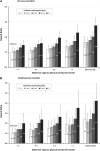Amount of time spent in sedentary behaviors and cause-specific mortality in US adults
- PMID: 22218159
- PMCID: PMC3260070
- DOI: 10.3945/ajcn.111.019620
Amount of time spent in sedentary behaviors and cause-specific mortality in US adults
Abstract
Background: Sedentary behaviors predominate modern life, yet we do not fully understand the adverse effects of these behaviors on mortality after considering the benefits of moderate-vigorous physical activity (MVPA).
Objective: We tested the hypotheses that higher amounts of overall sitting time and television viewing are positively associated with mortality and described the independent and combined effects of these sedentary behaviors and MVPA on mortality.
Design: In the NIH-AARP Diet and Health Study, we examined 240,819 adults (aged 50-71 y) who did not report any cancer, cardiovascular disease, or respiratory disease at baseline. Mortality was ascertained over 8.5 y.
Results: Sedentary behaviors were positively associated with mortality after adjustment for age, sex, education, smoking, diet, race, and MVPA. Participants who reported the most television viewing (≥7 h compared with <1 h/d) were at greater risk of all-cause (HR: 1.61; 95% CI: 1.47, 1.76), cardiovascular (HR: 1.85; 95% CI: 1.56, 2.20), and cancer (HR: 1.22; 95% CI: 1.06, 1.40) mortality after adjustment for MVPA. Overall sitting was associated with all-cause mortality. Even among adults reporting high levels of MVPA (>7 h/wk), high amounts of television viewing (≥7 h/d) remained associated with increased risk of all-cause (HR: 1.47; 95% CI: 1.20, 1.79) and cardiovascular (HR: 2.00; 95% CI: 1.33, 3.00) mortality compared with those reporting the least television viewing (<1 h/d).
Conclusions: Time spent in sedentary behaviors was positively associated with mortality, and participation in high levels of MVPA did not fully mitigate health risks associated with prolonged time watching television. Adults should be encouraged to reduce time spent in sedentary behaviors, when possible, and to participate in MVPA at recommended levels. The NIH-AARP Diet and Health Study was registered at clinicaltrials.gov as NCT00340015.
Figures

References
-
- Brownson RC, Boehmer TK, Luke DA, Brownson RC, Boehmer TK, Luke DA. Declining rates of physical activity in the United States: what are the contributors? Annu Rev Public Health 2005;26:421–43 - PubMed
-
- Pate RR, O'Neill J, Lobelo F. The evolving definition of “sedentary”. Exerc Sport Sci Rev 2008;36:173–8 - PubMed
-
- Levine JA, Lanningham-Foster LM, McCrady SK, Krizan AC, Olson LR, Kane PH, Jensen MD, Clark MM. Interindividual variation in posture allocation: possible role in human obesity. Science 2005;307:584–6 - PubMed

